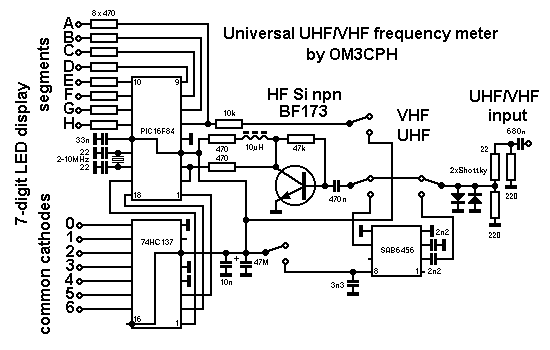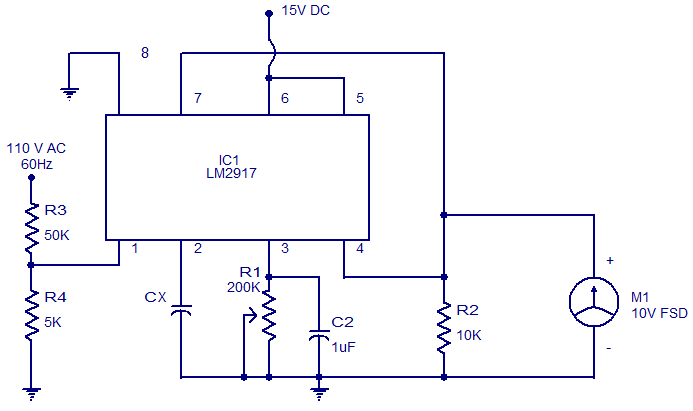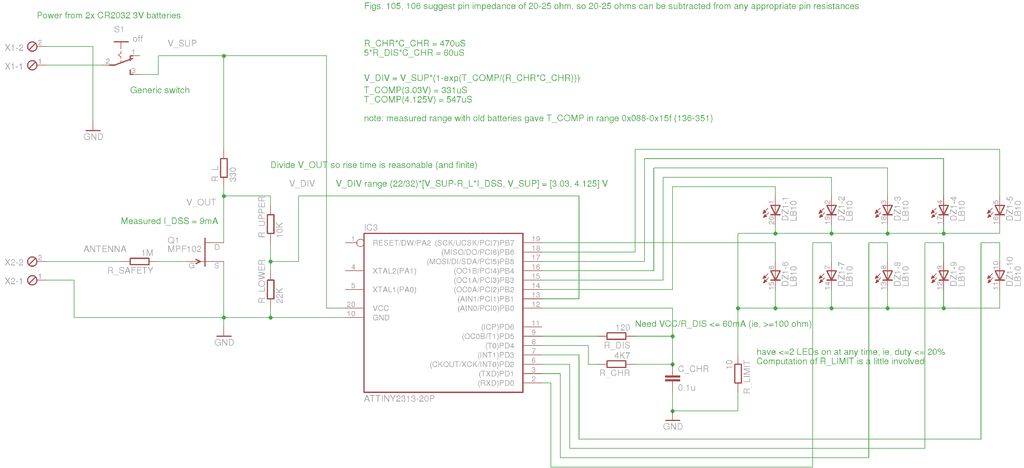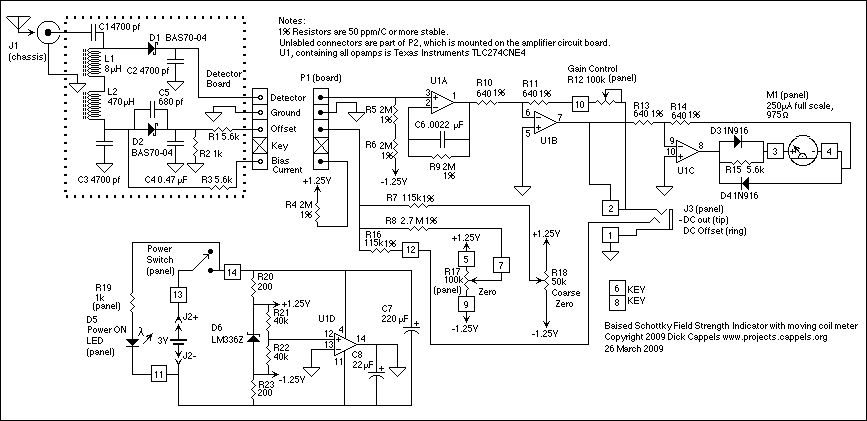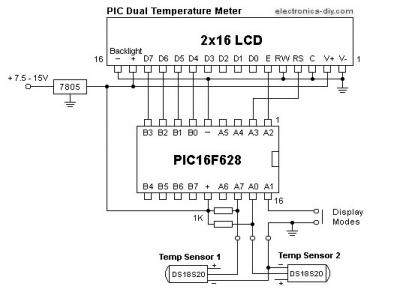
75 meter qrp ssb transceiver
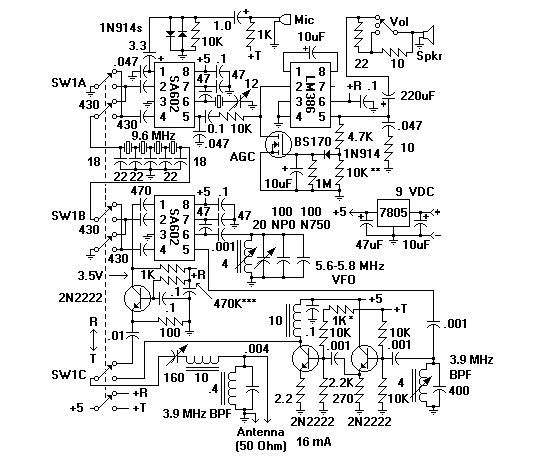
The transceiver switches the four-element 1500-ohm crystal band-pass filter (BPF) connections between the inputs and outputs of two SA602 integrated circuits to reverse the signal flow for receive/transmit (R/T) operation. Since no intermediate frequency (IF) amplifier is utilized in this design, an additional 20 dB of receiver gain is provided by a 2N2222 RF amplifier. Automatic gain control (AGC) is achieved through the peak DC swing of the LM386 output, which is processed through a rectifier, filtered by a capacitor, and applied to the gate of a BS170 enhancement-mode field-effect transistor (FET) that functions as a variable resistor at the input of the LM386. A 50-ohm antenna feeds into a half-pi band-pass filter (BPF, with a quality factor of Q=5), which is connected to the R/T switch. This switch directs the signal to the 2N2222 receive RF amplifier, which then connects to the first SA602. The output from the first SA602 returns to the R/T switch, leading to the four-element 1500-ohm crystal BPF, which subsequently connects to the second SA602. The output from the second SA602 feeds into the LM386, which has two outputs: one directed to a diode that connects to the capacitor and the gate of the BS170 for audio AGC, and the other to a speaker attenuator that leads to the speaker.
The transceiver circuit operates by efficiently managing the signal flow during both receiving and transmitting modes. The four-element 1500-ohm crystal BPF is crucial for filtering the desired frequencies, ensuring that only the relevant signals pass through to the amplifiers. The use of the SA602 integrated circuits allows for effective mixing and amplification of the RF signals, while the 2N2222 transistor provides significant gain to enhance weak incoming signals.
The LM386 serves as a low-voltage audio amplifier, which is essential for driving the speaker. The automatic gain control implemented via the BS170 FET dynamically adjusts the gain of the LM386 based on the output signal level, preventing distortion and ensuring consistent audio output levels regardless of variations in input signal strength. The rectification and filtering process ensures that the AGC circuit responds accurately to the audio signal variations, allowing for smooth operation during transmission and reception.
The entire setup is designed with careful attention to impedance matching, particularly with the 50-ohm antenna and the band-pass filter, to maximize power transfer and minimize signal loss. The integration of these components creates a robust transceiver capable of effective communication in various applications.In general, the transceiver switches the 4-element 1500 ohm xtal BPF ends between the inputs and outputs of the two SA602s to reverse the signal flow for R/T operation. Since no IF amplifier is used in the design, 20 dB of additional receiver gain is produced by the 2N2222 receiver RF amplifier, while automatic gain control (AGC) is produced by the peak DC swing of the
LM386 output passed through a rectifier and filtered by a capacitor and fed to the gate of a BS170 enhancement mode FET acting as a variable resistor across the input of the LM386. 50 ohm antenna feeds half-pi band pass filter (BPF, element Q=5) which feeds receive-transmit (R/T) switch which feeds 2N2222 receive RF amplifier which feeds 1st SA602 which feeds R/T switch which feeds 4-element 1500 ohm xtal BPF which feeds R/T switch which feeds 2nd SA602 which feeds LM386 which feeds 1) diode which feeds capacitor which feeds gate of BS170 which produces audio automatic gain control (AGC) and 2) speaker attenuator which feeds speaker.
🔗 External reference
The transceiver circuit operates by efficiently managing the signal flow during both receiving and transmitting modes. The four-element 1500-ohm crystal BPF is crucial for filtering the desired frequencies, ensuring that only the relevant signals pass through to the amplifiers. The use of the SA602 integrated circuits allows for effective mixing and amplification of the RF signals, while the 2N2222 transistor provides significant gain to enhance weak incoming signals.
The LM386 serves as a low-voltage audio amplifier, which is essential for driving the speaker. The automatic gain control implemented via the BS170 FET dynamically adjusts the gain of the LM386 based on the output signal level, preventing distortion and ensuring consistent audio output levels regardless of variations in input signal strength. The rectification and filtering process ensures that the AGC circuit responds accurately to the audio signal variations, allowing for smooth operation during transmission and reception.
The entire setup is designed with careful attention to impedance matching, particularly with the 50-ohm antenna and the band-pass filter, to maximize power transfer and minimize signal loss. The integration of these components creates a robust transceiver capable of effective communication in various applications.In general, the transceiver switches the 4-element 1500 ohm xtal BPF ends between the inputs and outputs of the two SA602s to reverse the signal flow for R/T operation. Since no IF amplifier is used in the design, 20 dB of additional receiver gain is produced by the 2N2222 receiver RF amplifier, while automatic gain control (AGC) is produced by the peak DC swing of the
LM386 output passed through a rectifier and filtered by a capacitor and fed to the gate of a BS170 enhancement mode FET acting as a variable resistor across the input of the LM386. 50 ohm antenna feeds half-pi band pass filter (BPF, element Q=5) which feeds receive-transmit (R/T) switch which feeds 2N2222 receive RF amplifier which feeds 1st SA602 which feeds R/T switch which feeds 4-element 1500 ohm xtal BPF which feeds R/T switch which feeds 2nd SA602 which feeds LM386 which feeds 1) diode which feeds capacitor which feeds gate of BS170 which produces audio automatic gain control (AGC) and 2) speaker attenuator which feeds speaker.
🔗 External reference
